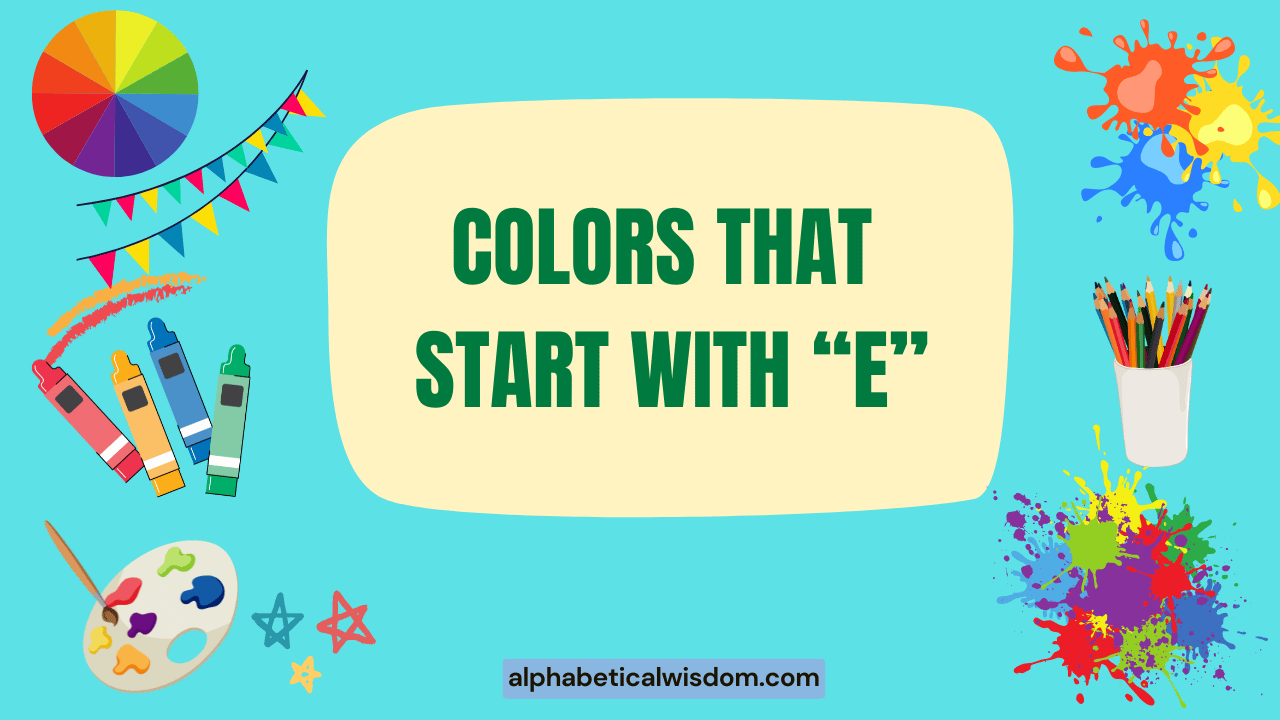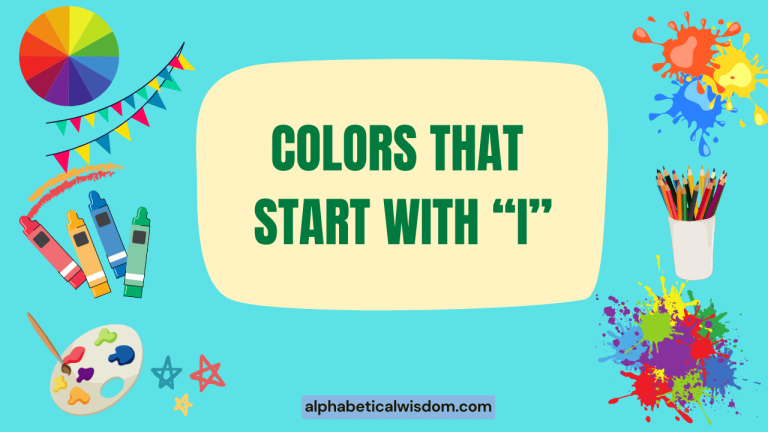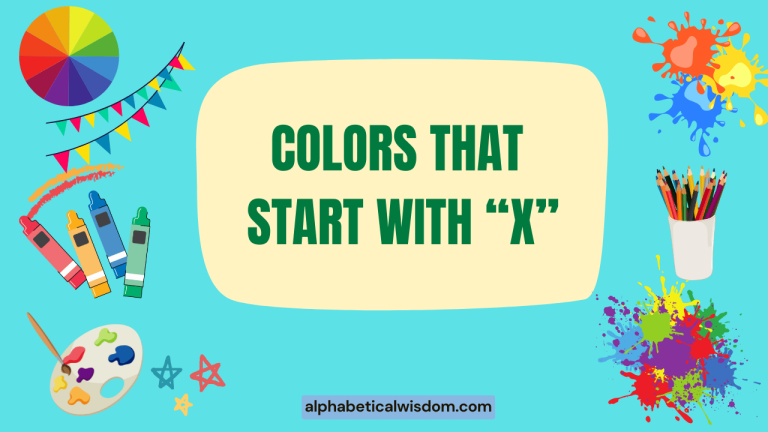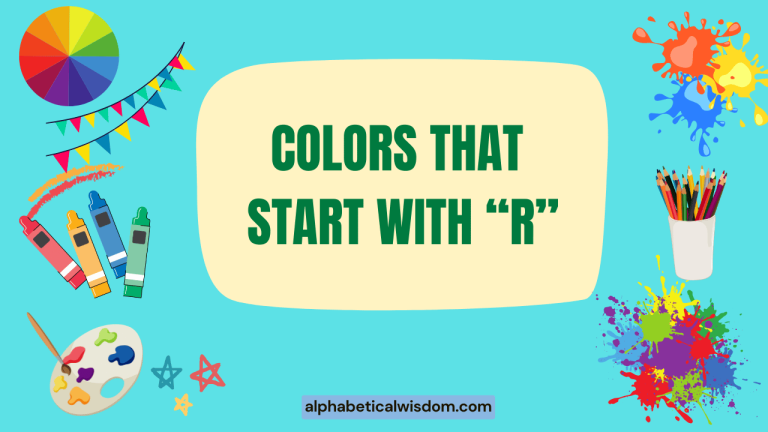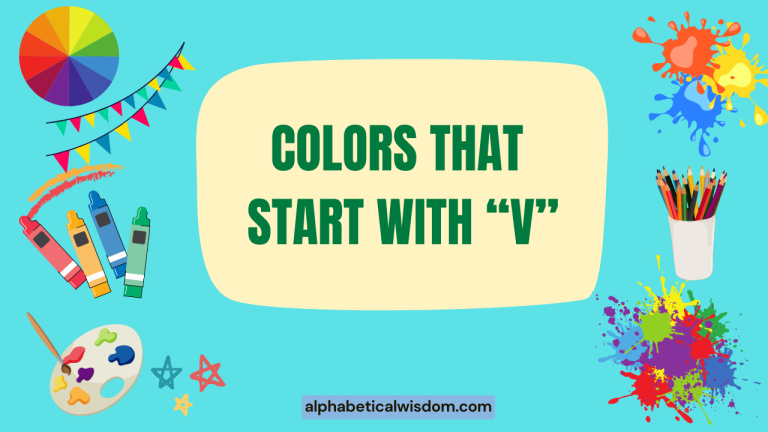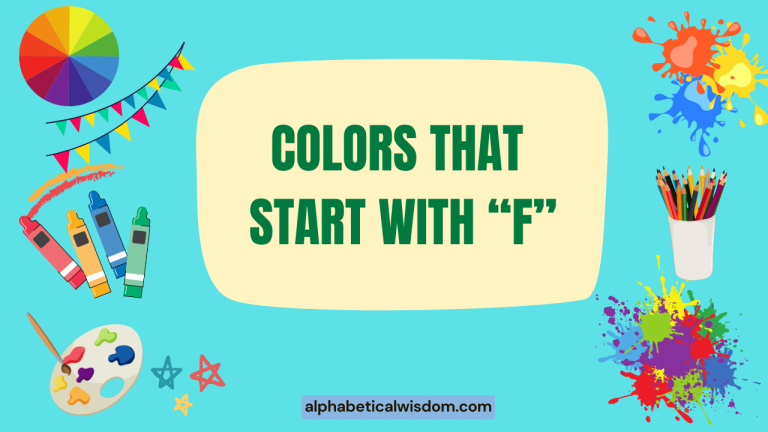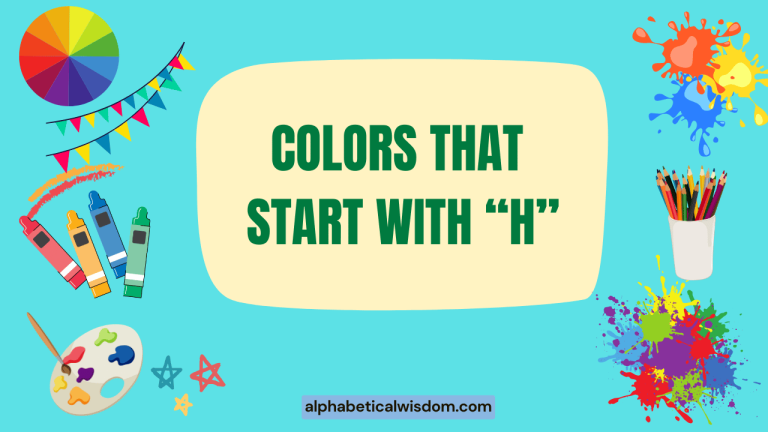Colors That Start With E: A Comprehensive English Guide
Understanding the nuances of color vocabulary in English enhances both descriptive writing and everyday communication. While the number of colors starting with ‘E’ may be limited, mastering their usage and context is valuable for anyone looking to improve their language skills.
This article provides a detailed exploration of colors that begin with the letter ‘E,’ including their definitions, variations, and practical applications. Whether you are an English language learner, a writer seeking precise vocabulary, or simply curious about color terminology, this guide will equip you with the knowledge and confidence to use these colors effectively.
This article is designed for English language learners, writers, artists, designers, and anyone interested in expanding their color vocabulary. By understanding the specific contexts and nuances of these colors, readers can improve their descriptive abilities and communicate more effectively.
The comprehensive examples, exercises, and explanations provided will help solidify your understanding and allow you to confidently incorporate these colors into your everyday language.
Table of Contents
- Introduction
- Definition of Colors Starting With ‘E’
- Structural Breakdown of Color Terminology
- Types and Categories of Colors Starting With ‘E’
- Examples of Colors Starting With ‘E’ in Sentences
- Usage Rules for Colors Starting With ‘E’
- Common Mistakes When Using Colors Starting With ‘E’
- Practice Exercises
- Advanced Topics in Color Terminology
- Frequently Asked Questions
- Conclusion
Definition of Colors Starting With ‘E’
The English language features a relatively small number of commonly used colors that begin with the letter ‘E.’ The most frequently encountered color is ecru. Let’s delve into a detailed definition of this color.
Ecru
Ecru is a grayish-yellow or light beige color. The term “ecru” comes from the French word écru, which means “raw” or “unbleached.” It is often used to describe the color of unbleached linen or silk. Ecru is considered a neutral color and is frequently used in interior design, fashion, and art.
Ecru is appreciated for its subtle warmth and versatility, making it a popular choice for backgrounds, textiles, and other applications where a soft, natural color is desired. Unlike stark white, ecru has a slight tint that adds depth and visual interest.
Its neutral nature allows it to pair well with a wide range of other colors, making it a staple in many design palettes. The color evokes a sense of understated elegance and natural beauty.
The classification of ecru falls under the category of neutral colors, specifically within the beige and off-white spectrum. Its function is primarily aesthetic, contributing to the overall look and feel of a design or composition.
Contextually, ecru is used in various fields, including:
- Fashion: For clothing, accessories, and footwear.
- Interior Design: For walls, furniture, and textiles.
- Art: As a background color or in combination with other colors in paintings and illustrations.
- Textiles: Describing the natural color of unbleached fabrics.
Structural Breakdown of Color Terminology
Understanding the structure of color terminology involves recognizing how colors are named, modified, and used in descriptive language. This includes understanding the base color, modifiers (such as adjectives), and the context in which the color is used.
A basic color term, like ecru, can be modified by adjectives to specify its shade, intensity, or tone. For instance, you might say “light ecru” or “dark ecru.” These modifiers provide more precise information about the specific color being described.
In addition to adjectives, adverbs can be used to further refine the description, such as “slightly ecru” or “almost ecru.” The structural breakdown can be visualized as follows:
(Adverb) + (Adjective) + (Base Color)
Here are some examples illustrating this structure:
- Slightly light ecru
- Almost dark ecru
- Very pale ecru
The context in which a color is used also plays a crucial role in its interpretation. For example, the phrase “ecru dress” implies a garment made of fabric in the ecru color.
The combination of the color term and the object it describes creates a complete and meaningful description. Understanding this structure allows for more precise and effective communication about colors.
Furthermore, color terminology extends beyond simple descriptions to include metaphorical and symbolic meanings. Colors can evoke emotions, associations, and cultural significance.
For example, ecru might be associated with simplicity, naturalness, or elegance, depending on the context and the individual’s perception. The structural understanding of color terms, combined with an awareness of their potential symbolic meanings, enhances one’s ability to use color language effectively and creatively.
Types and Categories of Colors Starting With ‘E’
While the list of colors starting with ‘E’ is limited, it’s important to understand the nuances and variations within the color category. The main color we’ll focus on is ecru, and we can explore its different shades and applications.
Variations of Ecru
Ecru, being a neutral color, has several variations that can be described using modifiers. Here are some examples:
- Light Ecru: A paler, more delicate version of ecru.
- Dark Ecru: A deeper, richer version of ecru.
- Warm Ecru: Ecru with a slightly warmer, yellowish undertone.
- Cool Ecru: Ecru with a slightly cooler, grayish undertone.
These variations allow for greater precision in describing the specific shade of ecru being referred to. For example, a “light ecru” wall might create a brighter, more airy feel in a room, while a “dark ecru” sofa might add a touch of sophistication and warmth.
Categorizing Ecru
Ecru can be categorized in several ways:
- By Tone: Light, medium, or dark.
- By Temperature: Warm or cool.
- By Application: Fashion, interior design, art, etc.
Understanding these categories helps in selecting the appropriate shade of ecru for a particular purpose. For instance, a designer might choose a warm ecru for a cozy living room or a cool ecru for a modern office space.
The categorization provides a framework for making informed decisions about color choices.
Additionally, ecru can be categorized based on its perceived similarity to other colors. It falls within the broader family of beige and off-white colors, sharing characteristics with colors like cream, ivory, and sand.
However, ecru has its unique qualities, distinguished by its specific blend of grayish-yellow hues. This categorization helps in understanding the relationships between different colors and their potential combinations.
Examples of Colors Starting With ‘E’ in Sentences
To fully understand how to use colors that start with ‘E,’ let’s look at some examples in sentences. We will focus on ecru and its variations.
Ecru in Fashion
The following table provides examples of how ecru can be used in sentences related to fashion.
| Sentence | Explanation |
|---|---|
| She wore an ecru dress to the party. | Describes the color of the dress. |
| The bride chose an ecru veil for her wedding. | Specifies the color of the veil. |
| He paired his navy suit with an ecru tie. | Indicates the color of the tie. |
| The model showcased an ecru blouse with black pants. | Describes the color of the blouse. |
| These ecru shoes are perfect for a summer outfit. | Specifies the color of the shoes. |
| The designer used ecru lace to embellish the gown. | Describes the color of the lace. |
| An ecru handbag completed her elegant look. | Indicates the color of the handbag. |
| The store offers a wide selection of ecru sweaters. | Specifies the color of the sweaters. |
| She accessorized with an ecru scarf. | Describes the color of the scarf. |
| These ecru trousers are both stylish and comfortable. | Indicates the color of the trousers. |
| The ecru lining added a touch of luxury to the coat. | Describes the color of the lining. |
| He preferred the ecru shirt over the white one. | Specifies the color of the shirt. |
| The ecru belt accentuated her waist. | Indicates the color of the belt. |
| She found a beautiful ecru shawl to keep warm. | Describes the color of the shawl. |
| The ecru gloves were a perfect match for her outfit. | Specifies the color of the gloves. |
| An ecru hat shielded her from the sun. | Indicates the color of the hat. |
| The ecru socks were made of soft cotton. | Describes the color of the socks. |
| He chose an ecru pocket square for the event. | Specifies the color of the pocket square. |
| The ecru cardigan was perfect for a chilly evening. | Indicates the color of the cardigan. |
| She loved the ecru buttons on the coat. | Describes the color of the buttons. |
| The ecru trim added a subtle detail to the dress. | Specifies the color of the trim. |
| He opted for an ecru linen suit. | Indicates the color of the suit. |
| The ecru stitching enhanced the design of the bag. | Describes the color of the stitching. |
| She bought an ecru tote bag for everyday use. | Specifies the color of the tote bag. |
These examples show how ecru is effectively used to describe various fashion items, enhancing clarity and detail.
Ecru in Interior Design
Here are some examples of using ecru in the context of interior design.
| Sentence | Explanation |
|---|---|
| The walls were painted a soft ecru color. | Describes the color of the walls. |
| She chose ecru curtains to complement the room. | Specifies the color of the curtains. |
| The sofa was upholstered in ecru fabric. | Indicates the color of the sofa. |
| The designer used ecru cushions to soften the look of the room. | Describes the color of the cushions. |
| These ecru rugs added warmth to the floor. | Specifies the color of the rugs. |
| The ecru lampshade diffused a gentle light. | Indicates the color of the lampshade. |
| She decorated with ecru vases filled with flowers. | Describes the color of the vases. |
| The ecru bedding created a serene atmosphere. | Specifies the color of the bedding. |
| He preferred ecru blinds over stark white ones. | Indicates the color of the blinds. |
| The ecru wallpaper featured a subtle pattern. | Describes the color of the wallpaper. |
| The ecru cabinets gave the kitchen a classic look. | Specifies the color of the cabinets. |
| She selected ecru tiles for the bathroom floor. | Indicates the color of the tiles. |
| The ecru paint brightened up the hallway. | Describes the color of the paint. |
| The ecru trim highlighted the architectural details. | Specifies the color of the trim. |
| She loved the ecru accents in the room. | Indicates the color of the accents. |
| The ecru curtains were made of linen. | Describes the color of the curtains. |
| He chose an ecru bedspread for the guest room. | Specifies the color of the bedspread. |
| The ecru desk blended seamlessly with the decor. | Indicates the color of the desk. |
| She used ecru placemats on the dining table. | Describes the color of the placemats. |
| The ecru picture frames added a touch of elegance to the wall. | Specifies the color of the picture frames. |
| He installed ecru shelves to display his books. | Indicates the color of the shelves. |
| She paired the ecru furniture with brighter accessories. | Describes the color of the furniture. |
| The ecru walls provided a neutral backdrop for the art. | Specifies the color of the walls. |
| He selected ecru grout for the bathroom tiles. | Indicates the color of the grout. |
These examples demonstrate the versatility of ecru in interior design, showing how it can be used to create different moods and styles.
Ecru in Art and Design
The following table illustrates the use of ecru in art and design contexts.
| Sentence | Explanation |
|---|---|
| The artist used ecru as a background color in the painting. | Describes the background color. |
| The designer chose an ecru font for the website. | Specifies the color of the font. |
| The logo featured an ecru emblem. | Indicates the color of the emblem. |
| She created an ecru collage using vintage paper. | Describes the color of the collage. |
| The graphic designer used ecru tones to create a calming effect. | Specifies the tone of the design. |
| The ecru paper gave the invitation a vintage feel. | Indicates the color of the paper. |
| He painted the sculpture with an ecru finish. | Describes the finish of the sculpture. |
| The ecru canvas provided a neutral base for the artwork. | Specifies the color of the canvas. |
| She designed an ecru poster with bold typography. | Indicates the color of the poster. |
| The ecru border framed the photograph beautifully. | Describes the color of the border. |
| The artist used ecru highlights to add depth to the painting. | Specifies the color of the highlights. |
| He created an ecru pattern for the textile design. | Indicates the color of the pattern. |
| The ecru shade in the illustration gave it a classic look. | Describes the color of the shade. |
| She printed the brochure on ecru paper. | Specifies the color of the paper. |
| The ecru background made the text more readable. | Indicates the color of the background. |
| He designed an ecru label for the product. | Describes the color of the label. |
| The ecru color scheme conveyed a sense of elegance. | Specifies the color scheme. |
| She used ecru filters to edit the photographs. | Indicates the color of the filters. |
| The ecru tone of the website created a welcoming atmosphere. | Describes the color tone of the website. |
| He chose an ecru theme for the presentation. | Specifies the theme color. |
| The ecru color palette was inspired by nature. | Describes the origin of the color palette. |
| She designed an ecru business card with minimalist details. | Indicates the color of the business card. |
| The ecru accents in the artwork added a subtle touch. | Describes the color of the accents. |
| He used ecru as a base for the watercolor painting. | Specifies the base color. |
These examples illustrate how ecru is utilized in various art and design projects, highlighting its versatility and aesthetic appeal.
Usage Rules for Colors Starting With ‘E’
Using color terms correctly involves understanding their specific meanings and how they interact with other words in a sentence. Here are some key usage rules for colors starting with ‘E,’ focusing primarily on ecru.
Adjective Placement
Color terms are typically used as adjectives, modifying nouns. The adjective usually precedes the noun it describes.
For example:
- Correct: The ecru wall.
- Incorrect: The wall ecru.
The adjective “ecru” comes before the noun “wall” to describe the color of the wall. This is a fundamental rule in English grammar for adjective placement.
Combining with Other Adjectives
When using multiple adjectives to describe a noun, the order generally follows a specific pattern, although color adjectives usually come before adjectives of origin, material, or purpose. For example:
- The beautiful ecru dress.
- The soft ecru fabric.
In these examples, “beautiful” and “soft” are general descriptive adjectives that precede the color adjective “ecru.” This follows the typical order of adjectives in English.
Using with Prepositions
Color terms can be used with prepositions to provide additional context or detail. For example:
- The painting featured shades of ecru.
- She decorated the room in ecru.
These examples show how prepositions like “of” and “in” can be used to specify the presence or application of the color ecru in a particular context.
Formal vs. Informal Usage
The use of color terms like ecru is generally appropriate in both formal and informal contexts. However, the level of detail and precision may vary depending on the audience and purpose.
In formal writing or professional settings, using specific color terms can enhance clarity and accuracy. In informal settings, the use of color terms can add richness and detail to descriptions.
Common Mistakes When Using Colors Starting With ‘E’
Even though the color vocabulary starting with ‘E’ is limited, some common mistakes can occur. Here are some examples and corrections.
Incorrect Word Order
One common mistake is placing the color adjective after the noun it modifies.
| Incorrect | Correct | Explanation |
|---|---|---|
| The wall color was ecru. | The wall was ecru. | Adjective should precede the noun. |
| Dress she wore ecru. | She wore an ecru dress. | Adjective should precede the noun. |
In English, adjectives typically come before the nouns they describe. Correcting the word order ensures clarity and grammatical accuracy.
Misspelling
Misspelling “ecru” is another common error.
| Incorrect | Correct | Explanation |
|---|---|---|
| The fabric was ecrue. | The fabric was ecru. | Correct spelling is “ecru.” |
| She liked the acru color. | She liked the ecru color. | Correct spelling is “ecru.” |
Always double-check the spelling of “ecru” to avoid this common mistake. Using a spell checker can be helpful.
Incorrect Context
Using “ecru” in an inappropriate context can also lead to confusion.
| Incorrect | Correct | Explanation |
|---|---|---|
| The sky was ecru. | The sky was gray. | “Ecru” is not typically used to describe the sky. |
| The grass was ecru. | The grass was green. | “Ecru” is not a natural color for grass. |
Ensure that the color term aligns with the object being described. “Ecru” is typically used for fabrics, interiors, or designs, not natural elements like the sky or grass.
Practice Exercises
Test your understanding of colors starting with ‘E’ with these practice exercises.
Exercise 1: Fill in the Blanks
Complete the following sentences with the correct form of “ecru.”
| Question | Answer |
|---|---|
| 1. She painted her bedroom walls ____. | ecru |
| 2. The wedding dress was a beautiful shade of ____. | ecru |
| 3. He wore an ____ shirt to the meeting. | ecru |
| 4. The curtains were made of ____ linen. | ecru |
| 5. The sofa was upholstered in ____ fabric. | ecru |
| 6. She chose ____ tiles for the bathroom. | ecru |
| 7. The invitation was printed on ____ paper. | ecru |
| 8. He designed an ____ logo for the company. | ecru |
| 9. The artist used ____ as a background color. | ecru |
| 10. The ____ rug added warmth to the room. | ecru |
Exercise 2: Correct the Sentences
Identify and correct the errors in the following sentences.
| Question | Answer |
|---|---|
| 1. The wall color was ecru. | The wall was ecru. OR The ecru wall. |
| 2. She wore dress ecru. | She wore an ecru dress. |
| 3. The fabric was ecrue. | The fabric was ecru. |
| 4. He painted the wall with ecru shade. | He painted the wall with an ecru shade. |
| 5. The curtains are ecru color. | The curtains are ecru. OR The curtains are ecru-colored. |
| 6. Ecru the sofa is beautiful. | The ecru sofa is beautiful. |
| 7. She bought shoes acru. | She bought ecru shoes. |
| 8. The paper ecru felt luxurious. | The ecru paper felt luxurious. |
| 9. The logo was design ecru. | The logo was ecru in design. OR The ecru logo. |
| 10. The rug made of ecru wool. | The rug was made of ecru wool. |
Exercise 3: Sentence Completion
Complete the sentences using appropriate phrases with “ecru.”
| Question | Answer |
|---|---|
| 1. For a calming effect, use shades ____. | of ecru |
| 2. The room was decorated ____. | in ecru |
| 3. She chose an ____ for her wedding. | ecru veil |
| 4. The walls were painted ____. | ecru |
| 5. He preferred the ____ over the white one. | ecru shirt |
| 6. The bedding was ____. | ecru |
| 7. She loved the ____ on the dress. | ecru trim |
| 8. The designer used ____ to create a vintage look. | ecru paper |
| 9. The artwork featured ____. | ecru highlights |
| 10. The website had a ____. | ecru tone |
Advanced Topics in Color Terminology
For advanced learners, understanding the nuances of color terminology goes beyond basic definitions and usage. It involves exploring the psychological and cultural significance of colors, as well as the technical aspects of color theory.
Color Psychology
Color psychology studies how colors affect human emotions and behaviors. Different colors can evoke different feelings, and these effects can vary across cultures.
For example, ecru is often associated with calmness, simplicity, and naturalness. Understanding these associations can be valuable in fields like marketing, advertising, and design, where color choices can significantly impact consumer perception and behavior.
Color Theory
Color theory is a scientific and artistic approach to understanding color mixing, combinations, and visual effects. It involves concepts like hue, saturation, value, and color harmony.
Advanced learners can benefit from studying color theory to gain a deeper understanding of how colors interact with each other and how to create visually appealing compositions. Understanding color palettes, complementary colors, and analogous colors can enhance one’s ability to use color effectively in various applications.
Cultural Significance of Colors
Colors can have different meanings and associations in different cultures. What may be considered a positive color in one culture could be viewed negatively in another.
For example, in some cultures, white is associated with purity and weddings, while in others, it is associated with mourning and funerals. Understanding these cultural differences is crucial for effective communication and design in a global context.
When using colors in international marketing or design projects, it’s important to research the cultural significance of those colors in the target audience’s culture.
Color Terminology in Literature and Art
In literature and art, colors are often used symbolically to convey deeper meanings and themes. Authors and artists carefully select colors to evoke emotions, create atmosphere, and represent abstract concepts.
Analyzing the use of color in literary works and artistic masterpieces can provide valuable insights into the author’s or artist’s intentions and the overall message of the work. For example, the use of ecru in a painting might symbolize simplicity, humility, or a connection to nature.
Frequently Asked Questions
Here are some frequently asked questions about colors starting with ‘E.’
- What does the color ecru represent?
Ecru typically represents neutrality, naturalness, and understated elegance. It is often associated with simplicity and a sense of calm. Its versatility makes it a popular choice for various applications, from fashion to interior design.
- How is ecru different from beige?
While both ecru and beige are neutral colors, ecru has a slightly more grayish-yellow tone, whereas beige tends to have a warmer, more brownish hue. Ecru is often described as the color of unbleached linen, while beige is more akin to the color of sand.
- What colors go well with ecru?
Ecru is a versatile color that pairs well with a wide range of other colors. It complements both warm and cool tones, making it easy to incorporate into various color schemes. Some popular color combinations include ecru with navy blue, ecru with forest green, and ecru with blush pink.
- Is ecru a warm or cool color?
Ecru is generally considered a neutral color with a slightly warm undertone. However, it can also appear cool depending on the specific shade and the colors it is paired with. The warmth or coolness of ecru can be adjusted by adding slight tints of yellow or gray.
- Can ecru be used in modern designs?
Yes, ecru is a popular choice in modern designs due to its versatility and understated elegance. It can be used to create a minimalist and sophisticated look, especially when paired with clean lines and simple shapes. Ecru can also be used to add warmth and texture to otherwise stark and modern spaces.
- What are some common uses of ecru in fashion?
In fashion, ecru is often used for clothing items such as dresses, blouses, and trousers. It is also a popular choice for accessories like scarves, handbags, and shoes. Ecru can be used to create a classic and timeless look, or it can be paired with bolder colors for a more contemporary style.
- How can I incorporate ecru into my home decor?
Ecru can be incorporated into home decor in various ways, such as painting walls, choosing ecru furniture, or using ecru textiles like curtains and rugs. It can be used to create a calming and inviting atmosphere, especially when paired with natural materials like wood and linen. Ecru is also a great choice for creating a neutral backdrop for bolder accent colors.
- What emotions does the color ecru evoke?
The color ecru typically evokes feelings of calmness, neutrality, and sophistication. It’s often associated with simplicity, naturalness, and a sense of understated elegance. Because it’s a soft and muted color, it can also evoke feelings of comfort and relaxation. In design, ecru is used to create a welcoming and serene atmosphere, making it a popular choice for spaces where relaxation and tranquility are desired.
- What is the etymology of the word “ecru”?
The word “ecru” comes from the French word écru, which means “raw” or “unbleached.” This etymology reflects the color’s association with natural, unbleached fabrics like linen and silk. The term was first used in English in the late 19th century to describe the color of these materials.
Conclusion
Mastering the use of colors, even those with limited representation like colors starting with ‘E,’ enhances your ability to communicate effectively and expressively in English. While ecru is the primary color in this category, understanding its variations, usage rules, and common mistakes is crucial for accurate and nuanced language use.
By practicing the examples and exercises provided in this article, you can confidently incorporate ecru into your vocabulary and improve your overall language proficiency.
Remember to pay attention to adjective placement, spelling, and context to avoid common errors. Continue to explore the broader field of color terminology and its cultural significance to further enrich your understanding and appreciation of language.
With consistent effort and attention to detail, you can master the art of using color terms effectively and creatively in your writing and speaking.
